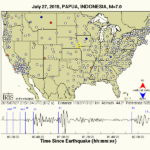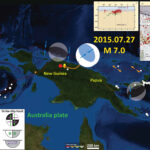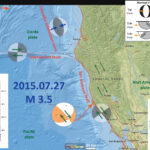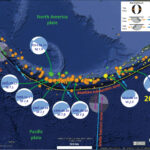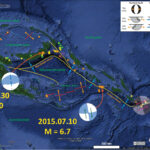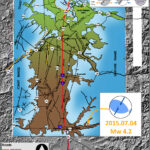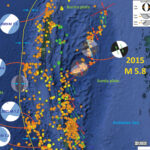There have been a few more data products produced for this earthquake (that has not had any aftershocks). IRIS has produced some educational material, called “teaching moments” (or, could be called, learning moments, heheh). However, their data are often poorly…
New Guinea Earthquake Update #1
Here is an update on the M = 7.0 New Guinea earthquake. Here is my first post about this earthquake. As I mentioned, there has been a flurry of seismic activity along the New Britain and Solomon trenches to the…
New Guinea Earthquake!
Moments ago we had a large magnitude earthquake (M = 7.0) on land in northeastern New Guinea, Indonesia. Here is the USGS website for this earthquake. Here is a preliminary map that shows estimates of ground shaking intensity based upon…
Small Earthquake near Point Arena!
Today we had a small magnitude, M = 3.5, earthquake near Point Arena. Based upon the location and focal mechanism, I interpret this to have been a north-northwest striking right-lateral (dextral) strike-slip earthquake. The fault that ruptured is likely either…
Fox Islands Earthquake!
Tonight we had a large earthquake along the Aleutian subduction zone. Here is the USGS web page for this M = 6.9 earthquake. Here is a map that shows some of the large earthquakes in this region from 1996 through…
Earthquake near the Santa Cruz Islands (western Pacific)!
We just had an earthquake near the Santa Cruz Islands in the western Pacific Ocean. Here is the USGS web page for this earthquake. Here is a map that I quickly put together with the moment tensor from the M…
Earthquake in the Solomons!
While I was away from the office, we had a M 6.7 earthquake near the Solomon Islands. Here is a link to the USGS website for the M = 6.7 and M = 6.0 earthquakes. While the epicenter plots near…
Springfield Earthquake!
It took me a couple days to catch up with things, so I missed posting about this earthquake until now. We had a Mw = 4.2 earthquake northeast of Eugene on the morning of 2015.07.04. Here is the USGS web…
Andaman Sea Earthquake!
Today we had a small earthquake in the Andaman Sea, west of Thailand and east of the Andaman Isles (India). The Andaman Sea is a region of backarc spreading and connects the Sumatra fault (a (strike-slip) sliver fault that accommodates…

